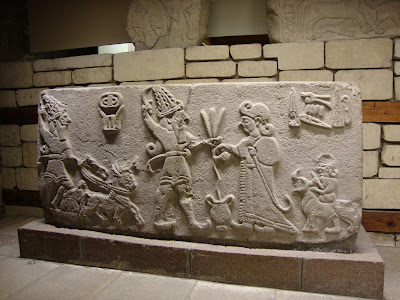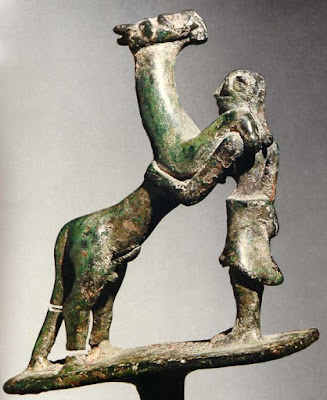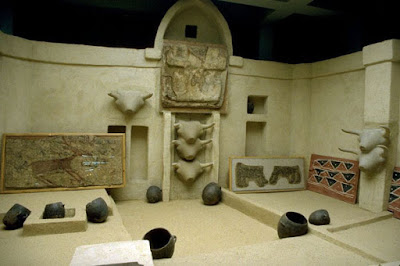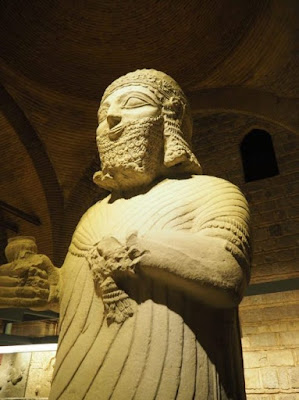The word "Anatolia" – Anatolia in its Greek origin – means the land where sun rises. The Roman named this land "theme Anatolia", meaning Eastland, because it was the East in regard to their own land.
Anatolia had hosted many civilizations which disappeared leaving their culture and artifacts to us.
Would you like to have a visit to the Museum of Anatolian Civilizations, which embodied the artifacts of these ancient civilizations?
It is one of the most important and awarded museums of the world with its distance collections. Archeologists artifacts from the first age upto now found in Anatolia are presented here. This museum in Altındağ district of Ankara. It was established on two Ottoman buildings which the next to the wall of Ankara Caslteat the neighborhood of at pazari and which were restored.
One of these buildings is Mahmut Pasha Bedesten (covered bazaar) which was ordered by veli Mahmut Basha, and the other one is kursunlu han (public house) which was built by Mehmet Pasha.
The story of the establishment of this museum is interesting. According to my research; the founder of the Turkish Republic Mustafa Kemal Atatürk , were travelling across the country to tell the importance on national independence in 1920. During this travel when he saw some historical artifacts around protectless, he ordered those artifacts to be gathered and sent to Ankara. As a history loving and inquisitive leader, he had the idea to establish a museum – Hittite museum – in mind.
In 1921 when the artifacts began to arrive at Ankara, the need for a place for keeping them appeared. Mübarek Galip Bey, who was responsible for culture in the cabinet at that time was assigned this duty. Mübarek Galip Bey established the first museum archive in Ankara at the walls of Ankara Castel, namely Akkale wall.
After the independence war, young Turkish Republic was found and a reform process began under the leadership of Atatürk. In 1932, Turkish Republic lost its leader. But Turkish nation held on to his idea of the museum. Hamit Zübeyir Koşay, the director of culture in Ankara, asked Saffet Ankan the minister of Education of the time to restore and use Mahmut Pasha Pedesten and Kurşunlu Han as a museum.
The idea was accepted and a restoration of 30 years from 1938 to 1968 began. Restoration of the museum was completed in 1968.
At the beginning, only the artifacts of the Hittites were presented at the museum. Then it was enriched by the artifacts of other civilizations and became a museum of Anatolian Civilizations.
In 1997, the museum was chosen for the Award of by European Museum Forum for the council of Europe among 68 candidates. It is the first and the only Museum in Turkey winning that Award.
I feel like going back to history in a time machine while I am entering any museum. Over 10 thousands of artifacts are presented here.
According to my research, Anatolia has the first place among the countries of the world with the number of civilizations it hosted. This fact makes me ask some questions:
The first is: why so many civilizations in Anatolia?
Anatolia is located at the crossroads of 2 continents. It was always attractive for the people as a bridge. Due to its location, Anatolia witnessed many waves of migration and occupation. The reasons for this are:
· It is surrounded by 3 seas.
· It is easy to connect with both Europe and Africa by the sea and the land.
· It has appropriate conditions of climate, fertile lands and many water resources.
As you can see when visiting the Museum of Anatolian Civilizations, the detailed information about the artifacts are given beneath the artifact. The artifacts are classified and presented according to their age, the civilization they belong and their characteristics.
The very well lightening and audio system inside the Anatolian Museum makes you feel that you are inside an exciting movie; it brings the time to you. It was possible to classify the civilization of Anatolia into 6 periods:
· Before Christ: Hittites, Phrygians, Lydians, Ionians, Urartus
· Persians: the last before Christ
· Empire of Alexander the Great
· Roman Empire
· Byzantine Empire
· Turks after 1071 AC
Let me introduce you these civilizations in short:
Hittites
It is estimated that they came from Caucasus to Anatolia. They settled around the river Kizilirmak. The capital was Hattusa (called Bogazkoy today) they had a battle with Egypt for the lands of today Syria and a treaty. The first treaty known in history, namely Qadesh was signed.
Phrygians
They established a state in the Middle Anatolia region around the river Sakarya. Their capital was Godion and they were destroyed by Cimmerians.
Lydians
The region between the rivers Gediz at the north and Menderes at the south was called Lydia. The capital was Sardos. They were successful in trade. The first money was used by the Lydians. They had an influence on the establishment of Royal Road from Epyesus to Nineveh in Mosopotamia.
They were destroyed by Persians.
Ionians
The region from the Gulf of izmir to the Gulf of Güllük was called lonia. The Achaeans, who came from Greece and merged with the residents of the region established city states.
The most important city states of lonia were Ephesus, Miletus, Smyrna, Phokaea and Halikarnassos. The temple of Artemis in Ephesus was built by Ionians. They were successful at sea trading.
Urartus
They established a state around Van Lake and its neighborhood. The capital was Tushba (Van today). The king of Urartus governed the state in the name of Haldi, the god of war. They were successful at mining.
Roman Empire
The Roman Empire was established in Italy and expanded in Europe, Asia and Africa. It was divided in two in 395 AC as West and East Roman Empires. West Roman Empire was destroyed in 476 AC.
Byzantine Empire
It is the East Roman Empire. The capital was Constantinapolis (Istanbul today) and it was destroyed by the Ottomans as the Ottoman sultan Mehmet the Conqueror conquered Istanbul in 1453.
The conquer of Istanbul is accepted as the beginning of a new era. The most famous artifacts of Byzantine are churches of Hagia Sophia, Hagia Eirena, Hora, Sergios and Bacchante and the cisterns of Basilica and Philoxenos.
Culture and State
Those states established in Anatolia was generally Kingdoms. The kings were also the head of army, Judiciary and the religion. Thus, the kings held all the political, military and religious power.
Religion and Belief
Polytheism was wide spread in Anatolia. Hittites believed in the Gods of front Asia apart from their own gods and Lydians believed in Greek Gods. This was the sign of interaction of religion in Anatolia. Urartus believed in after-life, therefore, they built their graves like houses and rooms and put some objects in it.
Social and Economic Life
The people were classified in social strata as the noblesse, the priests, the freemen and the slaves. The basis of the economy was agriculture besides trade and animal breeding.
Urartus were advanced in mining, Lydians in trade. Lydians were the first to use money and were influenced in the establishment of Royal Road. Ionians were successful in sea trading.
Script, Language and Literature
Assyrians brought Script to Anatolia. Hittites and Urartus used the cuneiform script of Assyrians and their own pictography. Lydians and Ionians used Phoenicia script. They were Ionians who transferred Phoenicia script in the west.
Science and Arts
Hittites embossed reliefs of gods on flattened rocks. Hittites and Phrygians were advanced in weaving. The carpets of Phrygians called TAPETAES were famous.
Urartus were known for their castles and aqueducts. Ionians were advanced in science and arts.
Those Civilizations who left their cultural heritage to those lands conveyed so many of their knowledge and artefacts that we still use their knowledge and look with admiration.
Some most famous examples are:
Tales and Pythagoras in mathematics, Herodotus in history, Hippocrates in medical, Diogenes in philosophy.
Many people from all around the world come to visit the Museum of Anatolian Civilizations to see those values. I suggest you to visit the museum any weekend. You will witness the astonishing historical wealth of this country.
The amount of artifacts that were smuggled abroad or sold unconsciously cannot be evaluated. Please, invite everybody to be sensitive to this issue.
In conclusion, the nations that protect their history and culture never disappears.























0 comments:
Post a Comment